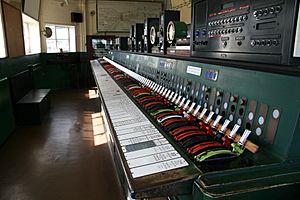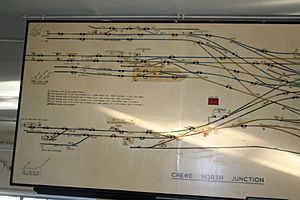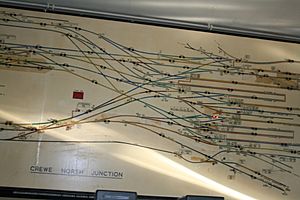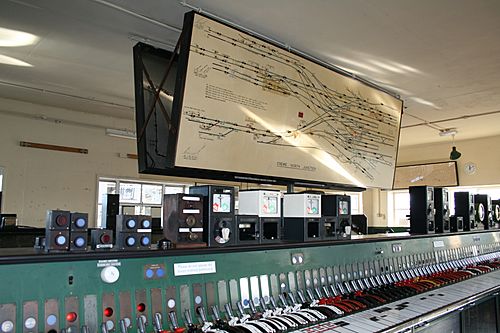Crewe North Junction signal box facts for kids
The Crewe North Junction signal box was a special building used to control train movements near Crewe railway station. Think of it as an air traffic control tower, but for trains. It had a large machine with many levers, called a Westinghouse Style 'L' lever frame. This signal box opened on March 29, 1940.
It was a very important control center for many years. It stopped being used on July 19, 1985, when the train station and tracks at Crewe were updated with new technology.
Contents
What Was a Signal Box?
A signal box is a building next to a railway line that houses the equipment for controlling train movements. People called signallers worked inside, pulling large levers. These levers changed the signals (like traffic lights for trains) and switched the tracks, guiding trains safely to the right platform or onto the correct line.
A Fortress for the Railway
The Crewe North Junction box was built in 1940, during World War II. Because of the danger of air raids, it was built to be incredibly strong. It had reinforced concrete walls that were 15 inches thick and a concrete roof that was 18 inches thick. This special design, known as an ARP (Air Raid Precautions) design, was meant to protect the important equipment and the signallers inside from bombs.
Location and What It Controlled
The signal box was located at a busy junction just north of Crewe railway station. From its windows, signallers could see the main West Coast Main Line and the lines going to Chester. They could also see the tracks leading to Manchester and Sandbach.
This position gave them a clear view of all the platforms on the north side of the station. They were responsible for safely guiding many trains in and out of Crewe every day.
How Did It Work?
Inside the signal box, a team of people worked together to keep the trains running smoothly and safely.
The Signalling Team
Usually, four people worked in the box:
- Two signallers who operated the levers.
- A signal box-lad who helped with tasks and communication.
- A regulator who managed the overall flow of trains.
In later years, the team was often just the two signallers and the box-lad.
Working with Other Signal Boxes
The Crewe North Junction box had to communicate with several other signal boxes nearby to pass trains along the line safely. They used a system called Absolute Block. This is a safety rule that makes sure only one train can be in a particular section of track at a time.
They used special bell codes and instruments to talk to the next box, for example, to let them know a "train is on the line." Once the train had safely passed and the signaller in the next box saw its tail lamp, they would signal back that the section was clear.
Some of the key boxes it worked with were:
- Crewe South Junction: This was the main partner box at the other end of the station. It closed in 1985, just before North Junction.
- Crewe Station 'A': This box controlled Platform 1. It was saved and moved to the Crewe Heritage Centre.
- Coal Yard: This box is further up the main line and is still open today.
- Steelworks: This box is on the line to Chester and is also still in operation.
The Track Layout
The signallers used a large diagram of the tracks to see where all the trains were. This diagram showed all the points (track switches) and signals they controlled. Below are parts of the diagram that was inside the box.
The Signal Box Today
Even though it's no longer used for the main railway, the Crewe North Junction signal box was saved. It still stands in its original spot and is now part of the Crewe Heritage Centre.
Visitors can go inside and see what it was like. A team of volunteers gives demonstrations, showing how the signallers used the giant lever frame to control the trains. It looks almost exactly as it did when it closed in 1985.
Signalling at Crewe Now
Today, all the signals and tracks around Crewe are controlled from a modern power signal box. This building uses computers and electronic panels instead of old-fashioned levers. It was opened in 1985 as a temporary solution but is still the control center for Crewe's busy railway network.





